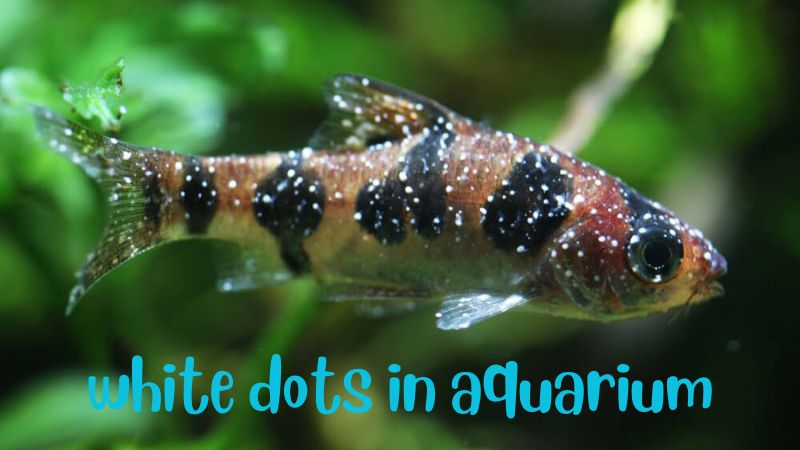Besides the brilliant beauty and serenity, aquariums also contain countless hidden dangers. Among them, white spot disease – “the silent enemy” – is always lurking and threatening the health of precious aquarium fish. This disease not only directly affects fish but can also spread quickly, leading to heavy damage to the entire aquarium. This article Tropical Fish Haven will help you learn more about white dots in aquarium fish
What is white dots in aquarium fish disease?
White spot disease is caused by a parasite called ich. This is one of the types of fungal diseases in fish that can appear in freshwater fish both in the wild and in artificial aquariums
When fish are attached to this parasite, white spots will appear on the surface of the fish’s scales, fins, and gills. That parasite will begin to reproduce, and signs of illness will spread to other fish.
If white spot disease is detected and treated promptly, the fish will have a high chance of recovery. Currently, there are drugs designed to kill parasites, not treat the associated symptoms of fish disease.
Signs of white spot disease
White spot disease is easy to recognize through tiny white spots floating on the fish’s body, fins, and gills. These white spots have the following characteristics:
- Sick fish look like they have been sprinkled with salt. The spots are raised and uneven on the fish’s scales.
- A few days after the fish becomes infected, you can count each blister.
- Spots multiply over time. After half a day or overnight, the white spots on the fish’s body can double or triple.
The time the salt-like spots stay on the fish depends on the temperature in the tank:
- From 24-26 degrees Celsius: 2 days
- From 21-23 degrees Celsius: 4 days
- From 15-20 degrees Celsius: 10-14 days
- From 10-14 degrees Celsius: 22-34 days
After the parasites fall off and begin to reproduce in the tank, no white spots will appear on the fish. This is the right time to kill the parasite before it attaches back to the fish.
Treatment of white spot disease
White spot disease is very dangerous if not treated promptly.
The ich parasite is especially dangerous in community aquariums because it reproduces rapidly and exponentially. Ich continues to reproduce until all its fish hosts die, so detecting the disease early is essential.
As mentioned, treating white spots is easy and there are many ways for you to choose from.
Some aquarium hobbyists do not want to treat with chemicals, so they will usually wait to see if the fish develops a natural immunity. However, treating white spot disease is a safer solution in the long run.
Treatment for white spot disease must last at least the entire life cycle of the parasite. The life cycle of the parasite depends on water temperature. The life cycle of parasites is shortened in high-temperature environments; With cold temperatures, the life cycle will be longer.
How to treat white spots
- Start treatment as soon as your fish shows symptoms.
- The ich parasite can only be treated when it drops from its host and reproduces in the water. Therefore, it is best to treat the aquarium rather than treat infected fish.
- Treatment must be maintained for at least a week to kill newly hatched parasites as well as those shed from infected fish as they progress through their life cycle.
However, some strains of ich bacteria are resistant to medication, so combine treatment methods to ensure the aquarium is completely free of ich parasites.
Choose appropriate medicine to treat white spot disease
Chemicals are the most reliable way to get rid of white spot disease in aquariums. Here are some popular methods:
- Ich-X: Effective at a wide range of temperatures and can be used with scaleless fish. However, this type is not safe for some invertebrates.
- API Super Ick Cure: Safe for scaleless fish and works quickly in both freshwater and saltwater lakes. Not recommended for reef aquariums.
- Seachem Paraguard: Safe for most plants, invertebrates, and scaleless fish at 1/2 or 1/4 dose and does not require water changes between doses. However, with this type, the treatment time will be slower.
- Seachem Cupramine: Highly effective and safe for most types of fish. Not suitable for beginners who need to carefully monitor tank conditions.
- Tetra Ick Guard: Comes in pre-measured tablets to prevent overdose and does not require water or temperature changes. Suitable for beginners but not safe for saltwater tanks.
To make sure the medicine is suitable for your aquarium, you need to read the instructions before using it.
Chemical treatment
- Increase the temperature in the lake from 25-27 degrees Celsius within 48 hours. Warmer temperatures will speed up the life cycle of the ich parasite, allowing for faster treatment.
- Turn off the UV sterilizer and protein skimmer, and remove carbon from any carbon filters. Otherwise, the medicine will not work.
- Aerate the tank, as both of these often deplete the tank’s oxygen levels. Purchase and install an air bubbler if the tank is not equipped with one
- Before adding any ich parasite treatment, calculate the actual amount of water in your tank.
If chemical treatment requires water changes, be sure to maintain a stable temperature in the tank to avoid fish stress.
When the treatment time is over, slowly lower the aquarium temperature to normal and continue with carbon filtration or UV disinfection.
To make sure the ich parasite is gone, monitor your tank for 2–4 days after finishing treatment.
In short, a chemotherapy treatment for white spot disease can take 2 to 3 weeks.
Change the environment
Some aquarists worry about treating fish with chemicals, so there are some natural ways to treat white spots:
- Increased temperature: Most strains of ich cannot live above 30ºC. So slowly increasing the temperature of the tank is enough to eliminate the parasites. However, not all fish can withstand heat, even fish that can withstand warm water still need supplemental oxygen.
- Add salt: Even freshwater fish can tolerate a little added aquarium salt for a short period of time. This method is only suitable for fish with scales. Adding salt can stop new infections before they get worse.
- Once the infection disappears, do several water changes to remove the salt from the tank. Putting infected fish in a “hospital aquarium”: Although this method cannot treat an infection, it does help you remove parasites and clean the aquarium more easily.
Typically, natural treatments for white spot disease are less effective than chemical treatments.
How to prevent white spot disease
- Buy fish that are healthy and show no signs of illness. Absolutely do not buy fish from lakes with dead or sick fish.
- You should quarantine newly purchased fish, aquatic plants, and decorative objects for at least 2 weeks before releasing them into the tank.
- Observe the fish every day to promptly detect if the fish is infected.
- Avoid buying aquatic plants from tanks that already have fish. If not, wash the plant thoroughly and ensure safety within 4 days.
In short, to prevent white spot disease, quarantine all newly purchased fish and regularly check for unusual symptoms.
Final Thoughts
Although white spot disease is dangerous, it can be completely prevented and treated effectively if detected early and correct measures are applied. Equipping yourself with complete knowledge about the causes, signs and treatments of diseases is extremely important to protect the health of your pet fish and keep the aquarium always clear and vibrant.





